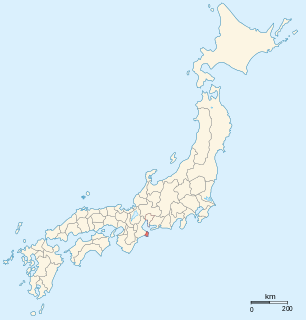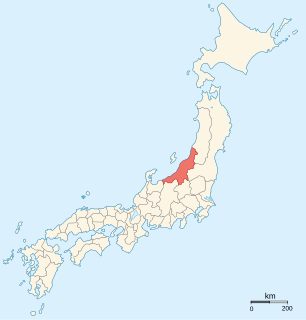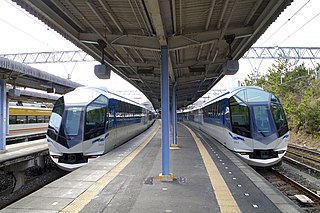| Native name: (答志島) | |
|---|---|
 Tōshijima from Sugashima | |
| Geography | |
| Location | Mie Prefecture |
| Coordinates | 34°31′13″N136°52′39.4″E / 34.52028°N 136.877611°E Coordinates: 34°31′13″N136°52′39.4″E / 34.52028°N 136.877611°E |
| Area | 6.98 km2 (2.69 sq mi) |
| Coastline | 26,300 m (86,300 ft) |
| Highest elevation | 167.2 m (548.6 ft) |
| Administration | |
Japan | |
| Demographics | |
| Population | 2,981 (2000) |
| Ethnic groups | Japanese |
Tōshijima(答志島) is an inhabited island located in Ise Bay off the east coast of central Honshu, Japan. It is administered as part of the city of Toba in Mie Prefecture. It is the largest of the outlying islands of Toba.

Ise Bay is a bay located at the mouth of the Kiso Three Rivers between Mie and Aichi Prefectures in Japan. Ise Bay has an average depth of 19.5 metres and a maximum depth of 30 metres toward the centre. The mouth of the bay is 9 kilometres wide and is connected to the smaller Mikawa Bay by two channels: the Nakayama Channel and the Morosaki Channel. Mikawa Bay is subsequently joined to the Pacific Ocean by the Irako Channel, which ranges from 50 to 100 metres in depth.
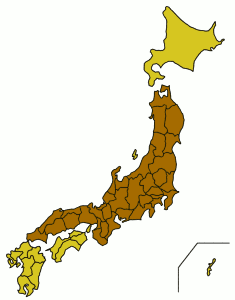
Honshu is the largest and most populous island of Japan, located south of Hokkaido across the Tsugaru Strait, north of Shikoku across the Inland Sea, and northeast of Kyushu across the Kanmon Straits. The island separates the Sea of Japan, which lies to its north and west, from the North Pacific Ocean to its south and east. It is the seventh-largest island in the world, and the second-most populous after the Indonesian island of Java.
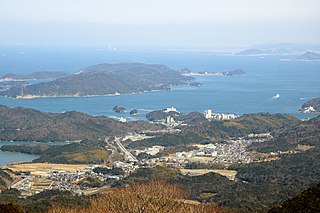
Toba is a city located in Mie Prefecture, Japan.
The name of Tōshijima appears in early documents, such as the Man'yōshū and Wamyō Ruijushō, and was a base for pirates led by Kuki Yoshitaka in the Sengoku period.
The Man'yōshū is the oldest existing collection of Japanese poetry, compiled sometime after AD 759 during the Nara period. The anthology is one of the most revered of Japan's poetic compilations. The compiler, or the last in a series of compilers, is today widely believed to be Ōtomo no Yakamochi, although numerous other theories have been proposed. The last datable poem in the collection is from AD 759 (No. 4516). It contains many poems from much earlier, many of them anonymous or misattributed, but the bulk of the collection represents the period between AD 600 and 759. The precise significance of the title is not known with certainty.
The Wamyō ruijushō or Wamyō ruijūshō is a 938 CE Japanese dictionary of Chinese characters. The Heian period scholar Minamoto no Shitagō began compilation in 934, at the request of Emperor Daigo's daughter. This Wamyō ruijushō title is abbreviated as Wamyōshō, and has graphic variants of 和名類聚抄 with wa 和 "harmony; Japan" for wa 倭 "dwarf; Japan" and 倭名類聚鈔 with shō 鈔 "copy; summarize" for shō 抄 "copy; annotate".
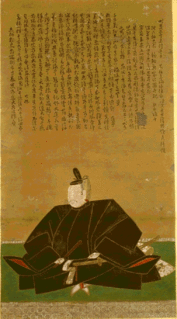
Kuki Yoshitaka was a naval commander during Japan's Sengoku Period, under Oda Nobunaga, and later, Toyotomi Hideyoshi. He was also the ninth headmaster of the Kuki family's school of martial arts, Kukishin-ryū and thus a very skilled warrior.
During the Meiji period, the island was made part of Tōshi District(答志郡), which became part of Shima District from 1896. On November 1, 1954, the island became part of the city of Toba. The economy of the island is based on commercial fishing, aquaculture and tourism.

The Meiji period, or Meiji era, is an era of Japanese history which extended from October 23, 1868 to July 30, 1912. This era represents the first half of the Empire of Japan, during which period the Japanese people moved from being an isolated feudal society at risk of colonisation by European powers to the new paradigm of a modern, industrialised nationstate and emergent great power, influenced by Western scientific, technological, philosophical, political, legal, and aesthetic ideas. As a result of such wholesale adoption of radically-different ideas, the changes to Japan were profound, and affected its social structure, internal politics, economy, military, and foreign relations. The period corresponded to the reign of Emperor Meiji and was succeeded upon the accession of Emperor Taishō by the Taishō period.
Shima was a district located in Mie Prefecture, Japan.

Commercial fishing is the activity of catching fish and other seafood for commercial profit, mostly from wild fisheries. It provides a large quantity of food to many countries around the earth, but those who practice it as an industry must often pursue fish far into the ocean under adverse conditions. Large-scale commercial fishing is also known as industrial fishing. This profession has gained in popularity with the development of shows such as Deadliest Catch, Swords, and Wicked Tuna. The major fishing industries are not only owned by major corporations but by small families as well. The industry has had to adapt through the years in order to keep earning a profit. A study taken on some small family-owned commercial fishing companies showed that they adapted to continue to earn a living but not necessarily make a large profit. It is the adaptability of the fishermen and their methods that cause some concern for fishery managers and researchers; they say that for those reasons, the sustainability of the marine ecosystems could be in danger of being ruined.
- Port of Momotori
- Port of Wagu
- Port of Tōshi






